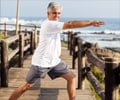Exercise improves walking ability of patients with peripheral artery disease, says new study based on clinical trial data.

‘Stem cell therapy did not result in improved walking performance, either alone or combined with exercise.’





Peripheral artery disease (PAD), which affects up to 20 percent of people older than 60, is a condition in which atherosclerotic blockages in the legs lead to pain or weakness when walking. There are few effective therapies to prevent mobility loss in people with PAD, although previous research led by McDermott demonstrated that certain exercise interventions can improve walking ability.
"There is a lot of interest in stem cell therapy, and this is the largest trial of this type of therapy conducted to date in people with blockages in their leg arteries," McDermott said. "It was disappointing that we did not see a benefit from this because so few therapies are available for patients with peripheral artery disease, and earlier research suggested this drug may be beneficial. More research is needed to identify new effective therapies."
In the current study, the investigators evaluated whether a stem cell-based therapy called granulocyte-macrophage colony-stimulating factor (GM-CSF), when administrated alone or combined with exercise, would lead to increased distance walked over six minutes.
GM-CSF is a drug designed to increase circulating stem cells in the blood, which had potential for improving walking performance in people with PAD, according to McDermott.
Advertisement
The team randomized 210 participants with PAD to one of four groups: GM-CSF with exercise, GM-CSF alone, exercise alone (with placebo) or a control that received no active therapies. The exercise consisted of supervised treadmill exercises completed three times weekly for six months. The GM-CSF and the placebo were administered via injection three times a week for the first two weeks of the intervention.
Advertisement
"Although this trial showed no added benefit of stem cell mobilization by GM-CSF in individuals with PAD, it yet again confirmed the benefits of exercise on walking capacity that have been observed in previous studies," said Dr. Diane Reid, a National Heart, Lung and Blood Institute (NHLBI) project officer for the study and a medical officer in the NHLBI Vascular Biology and Hypertension Branch. "Prompt reporting of negative clinical trial results, as done here, provides valuable information to guide the future directions of research on potential new therapeutics."
Source-Eurekalert















